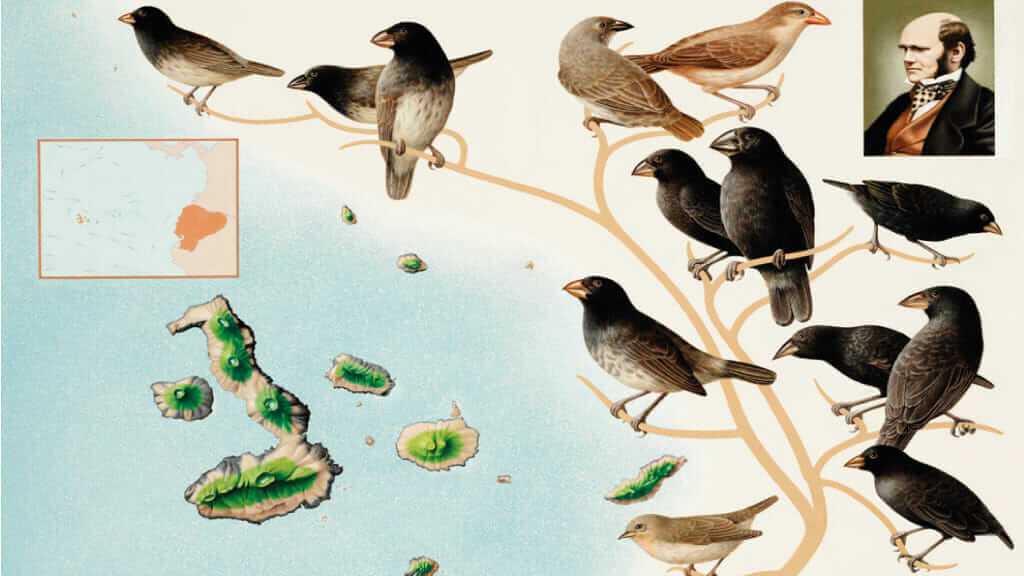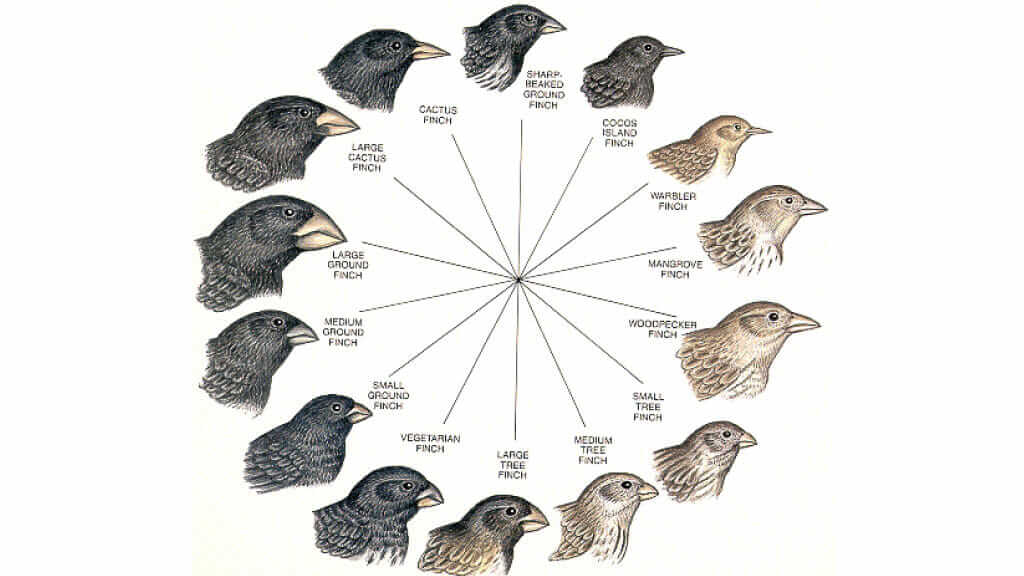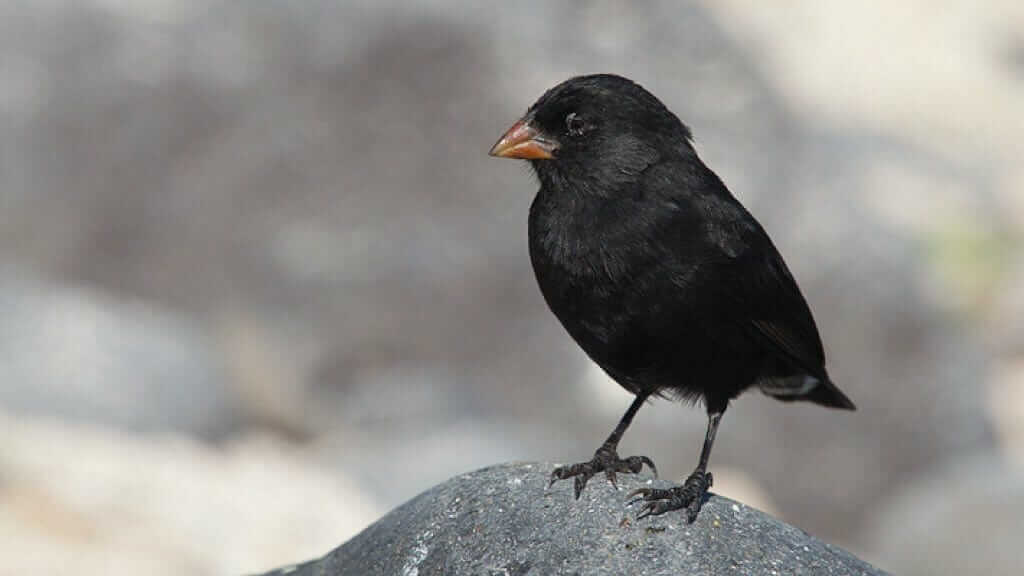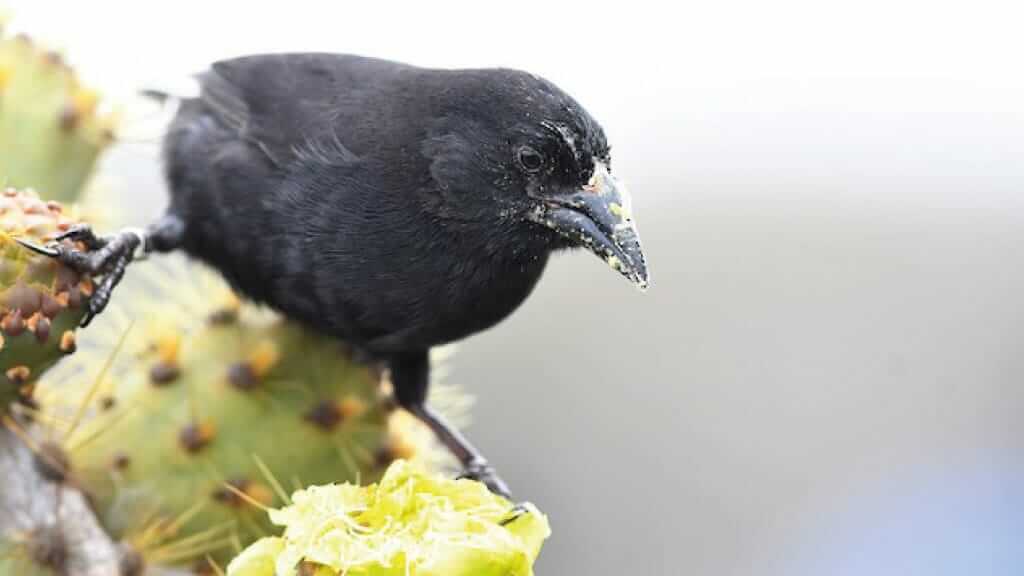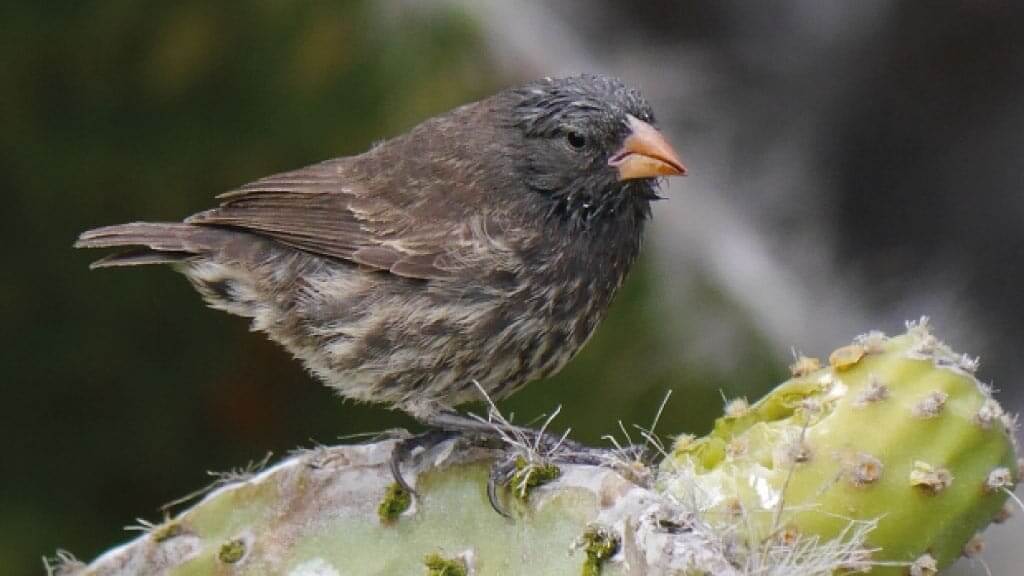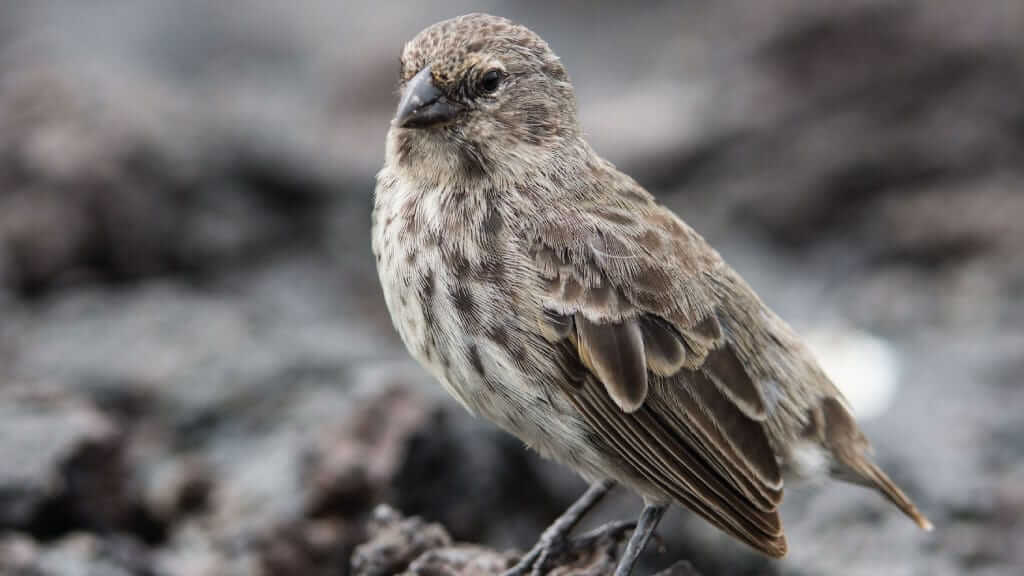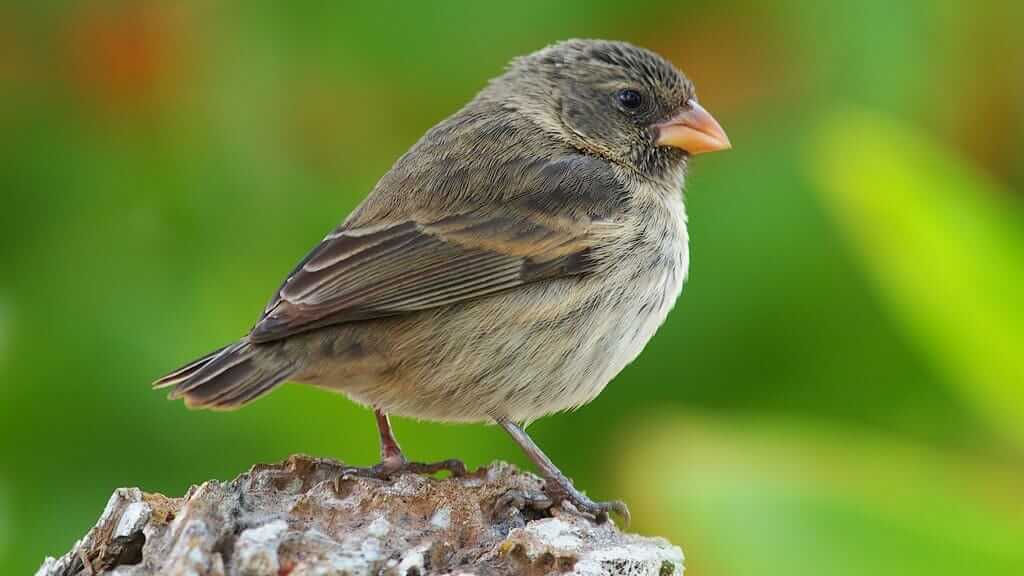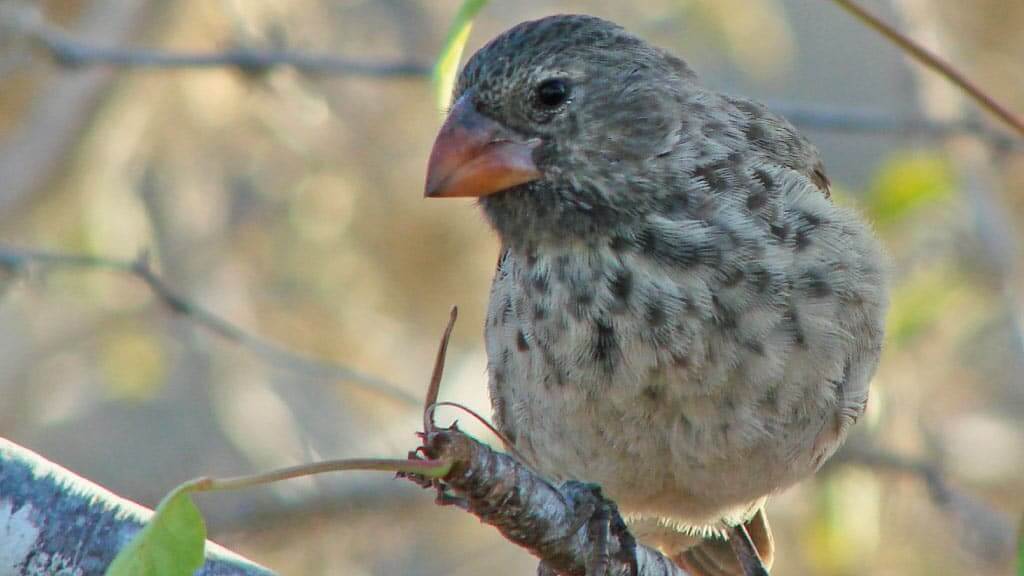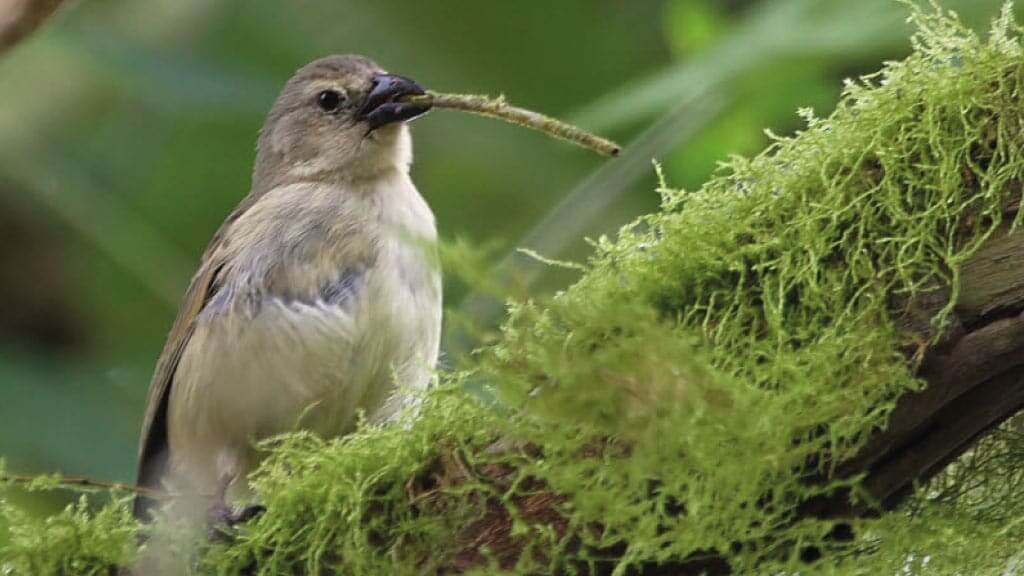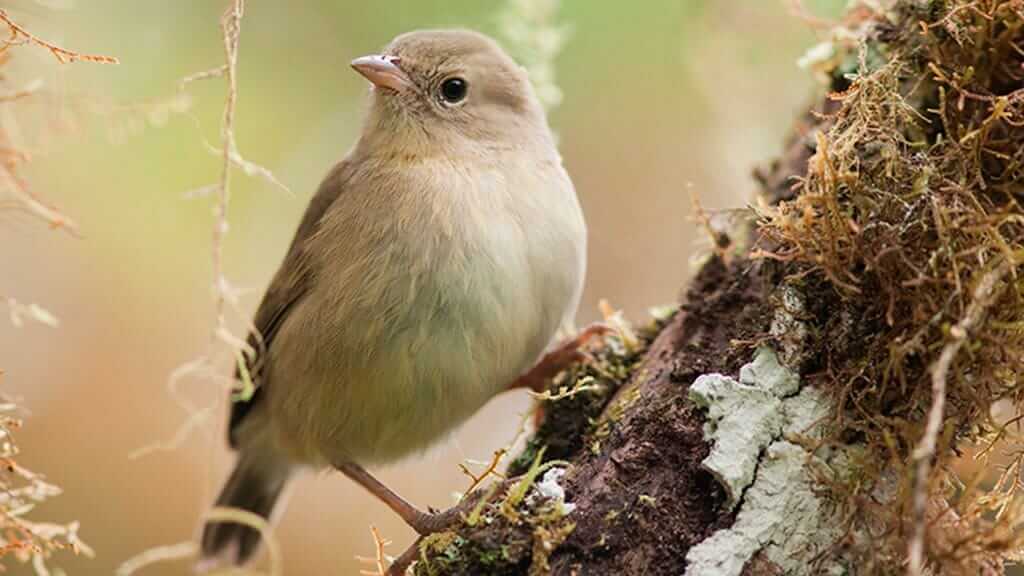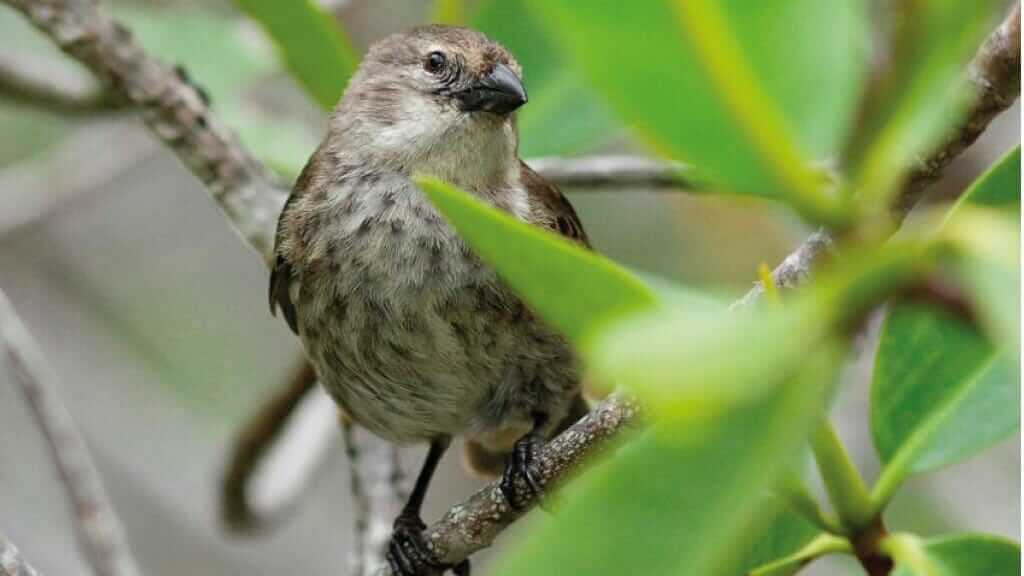GALAPAGOS FINCH (DARWIN'S FINCH)
In truth, the Galapagos Finch (also known as Darwin's Finch) may not be the most eye-catching bird that you see on the Galapagos Islands. They are neither colorful, nor big in size, and are in fact rather plain-looking. But what the Galapagos Finch may lack in beauty, it more than makes up for in importance to the natural world.
Galapagos Finches are one of the truly iconic birds of the Galapagos Islands. Why? All thanks to the work of one man – Charles Darwin. These little birds played a central role in his groundbreaking Theory of Evolution & Natural Selection. Today, Darwin’s Galapagos Finches give visitors a rare, first-hand view of evolution in action. An eye-opening moment of understanding the complex workings and history of nature.
For many Galapagos visitors, The Galapagos Finch may be the very first species that you encounter on the islands. They often flit around the airport arrivals area, searching for crumbs to eat at the cafe. This is exactly where their unique charm lies, they are friendly little fellas, and they have a pretty amazing story to tell.
So, let’s dive right in. Keep reading for everything you need to know about the humble Darwin Galapagos Finch. Why are Galapagos finches so famous? What does Charles Darwin have to do with it all? Which Galapagos Finch species can be spotted on the islands today? and how / where you can see them in person?
SECURE YOUR GALAPAGOS TRAVEL
Get a FREE personalised quote todayCharles Darwin & Galapagos Finches
In 1835, the voyage of the Beagle brought English botanist Charles Darwin to the Galapagos Islands. Here he found a species of bird that would shape natural history forever – the Galapagos Finch.
At first, Darwin did not appreciate the significance of the Finches. He was content to quickly collect samples and continue on his voyage. It was not until his return to England that it dawned on him that he had taken home various different, but related, species of Galapagos Finch. This led him to the realization that:
“Seeing this gradation and diversity of structure in one small, intimately related group of birds, one might really fancy that from an original paucity of birds in this archipelago, one species had been taken and modified for different ends.”
From these observations, Darwin’s famous Theory of Evolution was born. Human knowledge was changed forever, and the Galapagos Finch was named Darwin's Finch in his honor.
So, let’s delve deeper into the history of the Darwin Finch – What is the bird’s origin? and How exactly did they evolve at the Galapagos Islands?
Darwin's Galapagos Finch Evolution
So, how and why did the Galapagos Finch need to evolve?
Scientists believe that Darwin’s Finches are originally descended from the Grassquit. This bird species is still found today in mainland South America, including in Ecuador.
Over 2 million years ago the small Grassquit made an epic journey of more than 1000 km across the open ocean. Perhaps through flight, or more likely a combination of flight and rest on foliage drifting on the sea currents. Miraculously, the Grassquit somehow found its way to the small volcanic islands of the Galapagos Archipelago, far away in the Pacific Ocean.
By coincidence, Grassquits in fact migrated to various different islands in Galapagos. Let’s take a simple example to illustrate the point. Suppose that the humble grassquit arrived on 2 different islands, creating two separate populations of the original Grassquit species. Each island has distinct and different food sources and habitats. On one island the birds can feed easily on ground seeds from the abundant plant life, while on the other island cactuses are the most common plant and food source.
It is here that the story starts to get more interesting, as Natural Selection comes into play. On the first island, a short, stout beak was beneficial for eating seeds from the ground. So birds with this beak type were more likely to survive, mate, and pass the short beak trait onto their chicks. Meanwhile, on the second island, a longer pointed beak was far more useful to pierce cactus fruit and feed. So, likewise, this pointy beak trait meant a higher chance of survival and was passed genetically onto their chicks.
Now let’s fast forward over hundreds of thousands or more breeding generations. The advantageous beak traits on each island have been passed down to young birds many thousands of times. So, eventually, during this process, the size and shape of bird beaks between the two island populations have become significantly different. The birds on each island are now so different in appearance and behavior that they are recognized as separate species. Not only that, they are also now significantly different from the original pioneering South America Grasquit. So the same bird species that arrived in Galapagos has now evolved into two different and unique species of Galapagos Finch.
Let's take our example one step further. Now imagine that Grassquits originally arrived on many different Galapagos islands. Now we have many new bird species that have evolved from the one original bird. The diagram above gives a clearer idea of the different Galapagos Finch beaks that Darwin himself was able to observe in 1835. This demonstrates the complete cycle of Galapagos finch evolution.
In fact, today Galapagos Darwin's Finches can be differentiated not only by beak size and shape but also by body size, song, and feeding behavior.
As such, Darwin Finches are an exceptional example of the process of evolution of species. Back in the day, this was a very controversial discovery for Darwin, that went against the widely accepted belief of god as the one creator. Extrapolating this theory of evolution further, Darwin was able to theorize that long ago man had also evolved from apes.
At the Galapagos Islands, visitors can also find many other amazing species that have evolved to survive in their unique homes on different islands. Check out the iconic Giant Tortoise whose shell shape differs according to food sources and habitat on each island. Also, the Flightless Cormorant evolved to have tiny wings and has lost its ability to fly. The Marine Iguana is another great example – the only iguana in the world to have learned how to swim. The Galapagos Mockingbird also played an important role in helping Darwin to identify the subtle differences between subspecies on the different islands that he visited.
How to see Darwin's Finches at Galapagos?
The good news is that Darwin’s Finches are a common sighting on any vacation to the Galapagos Islands.
The Galapagos Finch is a land bird that can be spotted all year round. On either a Galapagos Cruise or a Galapagos Land Tour you will undoubtedly come face to beak with more Darwin Finches than you can imagine, often at close quarters as their curiosity gets the better of them.
Your naturalist guide will be happy to point them out to you and explain the adaptations made by each finch species over the years. It is often not easy to correctly identify between species as plumage is very similar. Try looking for differences in habitat, size, and beak shape, and don’t forget to take a beak chart with you to help with identification. See how many of the 13 Galapagos Finch species you can tick off.
Contact us for a FREE GALAPAGOS TOUR QUOTE, to plan your perfect Galapagos vacation to see Darwin’s Finches with your own eyes.
13 Galapagos Finch Species
Today there are more than 500,000 individual Darwin Galapagos Finches living in the Archipelago. They are divided into 13 different Galapagos Finch species, all endemic to the Galapagos Islands, meaning that you can only find them here, and nowhere else on Earth.
So, let’s learn a little more about each Galapagos Finch Species in turn, as well as on which islands you can find each one.
1. Common Galapagos Cactus Finch
Conservation Status: Least Concern
Scientific Name: Geospiza scandens
Lives on: Santa Cruz, San Cristobal, Isabela, Floreana, Santa Fe, Santiago, Genovesa, Rabida, North Seymour, Pinta, Daphne.
The Common Galapagos Cactus Finch was originally misidentified by Charles Darwin as a blackbird. Its beak is long, sharp, and pointed, enabling the bird to forage for food from Opuntia Cacti plants. They eat the nectar and pollen when in flower, or buds and seeds when out of season. They also feed on caterpillars and budworms. Like other Galapagos Finch species, the males are black from beak to tail, and the females are grey with striped plumage.
2. Large Galapagos Cactus Finch
Found only on Española Island, the aptly named Large Galapagos Cactus Finch uses its distinctive long, sharp, and pointed beak to feed on Opuntia Cactus nectar, buds, and seeds, as well as insects. Males have black plumage, while females sport grey feathers with streaks. Mating season takes place when the Galapagos rains come between December and June.
3. Sharp-beaked Ground Finch (or Galapagos Vampire Finch)
Conservation Status: Least Concern
Scientific Name: Geospiza difficilis
Can be seen on: Fernandina, Pinta, Darwin, Wolf
The wonderfully named Galapagos Vampire Finch gets its name from its unique feeding habits which include sucking the blood of large sea birds. Although typically a seed-eater, the Sharp-Beaked Ground Finch also eats seabird eggs and cactus nectar. Most commonly found on Fernandina and Pinta Islands, this species of Darwin Finch has become extinct in other parts of the Galapagos Islands.
4. Galapagos Small Ground Finch
The Galapagos Small Ground Finch is one of the most common species found on the Galapagos Islands, frequently spotted in towns or Galapagos airports. Their small finch beaks are perfect for picking up seeds from the ground, and they also enjoy eating bugs. Visitors often delight in seeing them sit on the backs of Giant Tortoise, waiting for bugs to land. The male Small Ground Finch is all black, and the females are brown with streaked plumage. Like other ground finches, Small Ground Finches mate during the rainy season, when the foliage of the islands blooms, producing enough food to sustain young chicks and fledglings.
5. Galapagos Medium Ground Finch
Conservation Status: Least Concern
Scientific Name: Geospiza fortis
Can be seen on: Santa Cruz, San Cristobal, Isabela, Fernandina, Floreana, Santa Fe, Santiago, Rabida, North Seymour, Pinta, Daphne, Marchena
Found on most Galapagos islands, the Medium Ground Finch’s adaptability has impressed scientists and naturalists during recent studies. Within this species, Galapagos Medium Ground Finches have both small and large beaks. On Daphne Major, the finches developed smaller beaks after a strong El Nino weather event, when an abundance of seeds was the primary food supply. Like the large ground finch, the male medium ground finch is black, and the female is mainly a non-descript dull gray. It can be rather challenging to tell the small ground finch apart from the medium ground finch.
6. Galapagos Large Ground Finch
Conservation Status: Least Concern
Scientific Name: Geospiza magnirostris
Can be seen on: Santa Cruz, Isabela, Fernandina, Santiago, Genovesa, Rabida, Pinta, Pinzon, Daphne, Marchena
The Galapagos Large Ground Finch is the largest of the thirteen Darwin's Finch species and also has the largest beak. They use their beaks to good effect cracking open nuts. The male’s feathers are black from beak to foot, while the female large ground finch’s plumage is brown with streaks. The Large Ground Finch mates for life, with the nesting season taking place between December and June when food supplies are most abundant.
GET FREE ADVICE
From a Galapagos destination expert today7. Galapagos Small Tree Finch
Conservation Status: Least Concern
Scientific Name: Geospiza parvula
Can be seen on: Santa Cruz, San Cristobal, Isabela, Fernandina, Floreana, Santa Fe, Santiago, Rabida, North Seymour, Pinzon, Daphne
The miniature, curved beak of the Small Tree Finch distinguishes it from the other 13 species in the group and makes the perfect tool to catch and eat insects. This Finch also feeds on seeds, fruit, and nectar, where males have black hoods and grey feathers, while females have browner feathers that are streaked. Besides beak shape, the easiest way to tell the Galapagos Small Tree Finch and Galapagos Small Ground Finch apart is through their behavior. Tree finch species are mostly spotted in the trees, while Ground Finches hop along the ground.
8. Galapagos Medium Tree Finch
Conservation Status: Critically Endangered
Scientific Name: Geospiza pauper
Can be seen on: Floreana
The Galapagos Medium Tree Finch can only be found in the Scalesia forests of Floreana Highlands and is on the IUCN Red List critically endangered list due to the impact of the Philornis Downsi parasitic fly. The fly’s larvae feed on the finch nestlings to such an extent that scientific studies suggest only 6% of active nests are able to produce fledglings. The Galapagos Medium Tree Finch has a curved, gripping beak that helps the greyish-brown and yellow birds feed on insects, seeds, and nectar.
9. Galapagos Large Tree Finch
Conservation Status: Vulnerable
Scientific Name: Geospiza psittacula
Can be seen on: Santa Cruz, Isabela, Fernandina, Santa Fe, Santiago, Rabida, Pinta, Marchena
Identified by its four-note song, faded green plumage, and black hood and breast, the Galapagos Large Tree Finch has a larger beak than the two other Tree Finch species, resembling that of a parrot. This Darwin finch species eats insects, caterpillars, spiders, seeds, and nectar, breeding between December and June, with eggs that hatch quickly, and chicks that fledge within two weeks of hatching.
10. Galapagos Woodpecker Finch
Conservation Status: Vulnerable
Scientific Name: Geospiza pallida
Can be seen on: Santa Cruz, San Cristobal, Isabela, Santiago
Found in both highland Scalesia forests and lowland arid zones the Galapagos Woodpecker Finch is one of the most innovative birds of the Galapagos Finch species. They use small twigs and cactus spines to dig into crevasses and cracks in trees, forcing insects and spiders out into the open to eat. They even use their long beaks to sharpen more appropriate tools for the job.
11. Galapagos Mangrove Finch
Conservation Status: Critically Endangered
Scientific Name: Geospiza heliobates
Can be seen on: Isabela
Galapagos Mangrove Finches are extremely rare to spot, found only in two small areas of mangrove forest on Isabela Island, and critically endangered due to breeding problems in these small populations. Mangrove Finches eat insects, with their thin and downward curving beaks able to penetrate tree bark to forage for food. The Charles Darwin Foundation is actively involved in trying to invigorate the Mangrove finch population. The station scientists collect eggs from nests on Isabela, hatch them in incubators, and raise the chicks in captivity until they are large enough to be released back into the Isabela wild.
12. Grey Warbler Finch
Conservation Status: Least Concern
Scientific Name: Certhidea fusca
Can be seen on: San Cristobal, Floreana, Española, Santa Fe, Genovesa, Pinta, Marchena
Named after their uncanny resemblance to the Warbler Species, there are two types of Warbler Finches in the Galapagos – grey and green. The Galapagos Grey Warbler Finch lives on the outlying islands of the archipelago, found in shrubland and dry forests of arid zones. Warbler Finches have a slender beak that they use to pierce tree bark in search of insects and spiders. Both Warbler Finch species use high-pitched, repetitive calls, repeated in quick succession.
13. Galapagos Green Warbler Finch
Conservation Status: Vulnerable
Scientific Name: Certhidea olivacea
Can be seen on: Santa Cruz, Isabela, Fernandina, Floreana, Española, Genovesa, Santiago, North Seymour, Rabida, Pinzon
Originally thought to be the same species as the Grey Warbler Finch, the Galapagos Green Warbler Finch was confirmed as a separate species in 2008. What is the difference between the two species of Galapagos Warbler Finch? They each have subtle differences in habitat, appearance, and song call. This Green Warbler Finch lives in the central islands of the Galapagos, in regions where Scalesia forests grow, and is often spotted around the Twin Craters (Los Gemelos) on Santa Cruz Island.
Conservation of Darwin’s Finches
Galapagos Darwin’s finches are under threat from a range of issues including introduced predators and diseases, habitat destruction, and the invasive parasitic fly Philornis Downsi. Fortunately, work is underway to protect them – keep reading for information about a couple of excellent active projects.
Today, the Galapagos Mangrove Finch is on the verge of extinction in the Galapagos Islands, with only around 100 individuals left, and as few as 20 breeding pairs. To keep these Galapagos Finches from disappearing altogether, the Charles Darwin Research Station and San Diego Zoo have partnered together in a captive breeding program.
The biggest threat to the Mangrove Finch is the parasitic Philornis Downsi fly larvae, which causes high mortality rates among finch offspring. During four months of caring for the chicks, the project team help them to develop the skills necessary for survival in the wild. Once they are capable of feeding for themselves, they are transferred to pre-release aviaries in the Isabela mangrove forests, where they have 4-6 weeks to adapt to their new habitat. Eventually, the aviary is left open so the Mangrove Finches can leave of their own accord. The birds are fitted with miniature tracking devices, and while some return to the aviary, many are happy in the wild.
In other ongoing studies, a group of international experts from various scientific institutions is conducting studies on genetic variations in the song and diet of Galapagos Finch species on Santa Cruz island. They want to see how the introduction of human food has changed the diet of the finches. Preliminary data suggests that there are important differences in behavior and diet at various sites. This project is run in partnership with the Ministry of Environment, Galapagos National Park, and the Charles Darwin Foundation, with financial support from the Earthwatch Institute.
Finally, research done by Peter Grant of Princeton University on Daphne Mayor Island, showed that changes in Finch beak sizes can be observed in just two or three generations. That is a much shorter period of time than was previously expected. This is due to weather conditions because the volume of rainfall is important for finches that feed on seeds. After the dry season, finches that survived drought had slightly wider beaks, a genetic trait which unsurprisingly is passed down to future generations of Galapagos Finch.
Book With The #1 Trusted
Galapagos Travel Agency
If you enjoyed reading this blog post, learn more about Galapagos land and marine Bird Species.
For more information about Galapagos Tours to see Darwin’s Finches first hand (as well as many other fascinating bird and mammal species), Contact a member of our team or call our toll-free numbers.
In conclusion, the Galapagos Finch is one of the true characters of the archipelago. Some tourists at first pay them little heed, in search of more exotic species instead. But for those with an active imagination, and desire for discovery, the humble Galapagos Darwin's Finch is a true wonder. Just remember the epic voyage of the grassquit arriving on these islands in the middle of the ocean. Imagine Darwin himself collecting and examining his specimens and his famous eureka moment. Take a moment to marvel at these little miracles of nature. Every single one of us owes a debt to the small Galapagos Finch.

